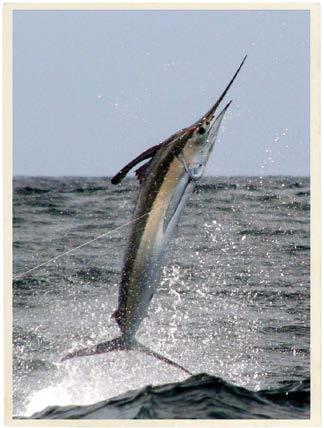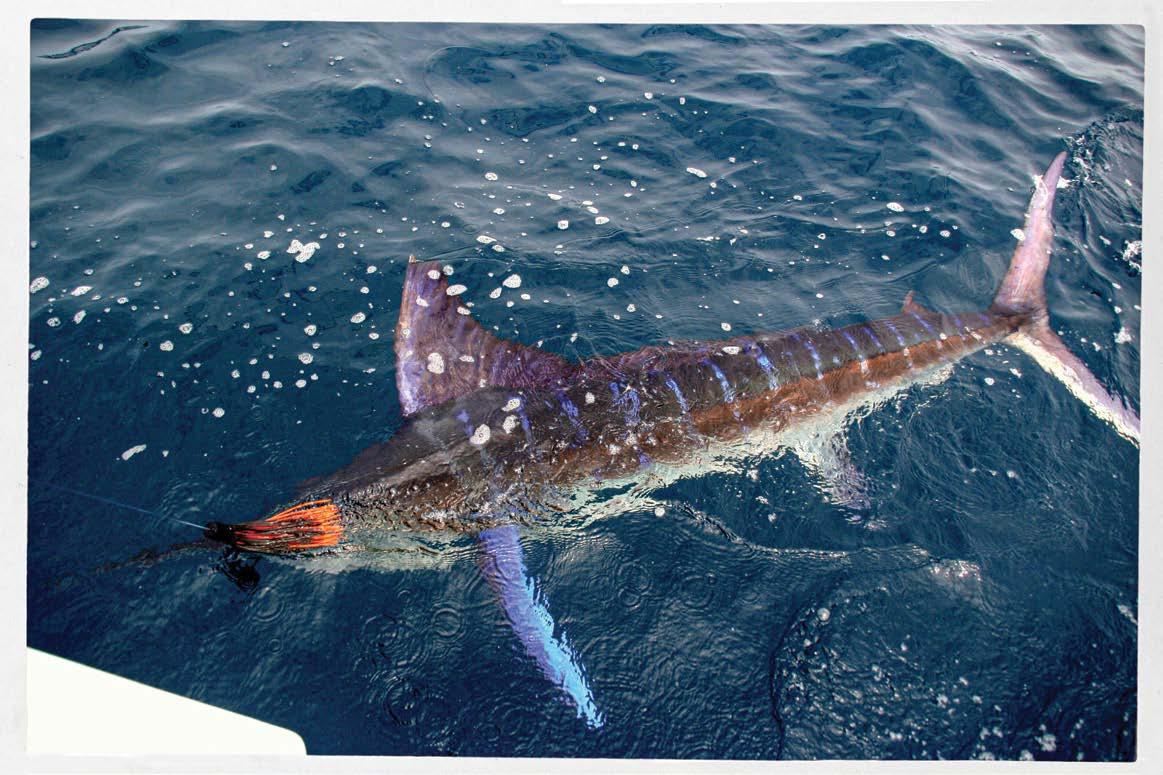
9 minute read
Land of the Striped Marlin
The striped marlin is the most abundant marlin species in the Eastern Tropical Pacific. They usually hunt in small packs, often working with marine mammals such as sea lions and dolphins in their search for prey. Acrylic on canvas, by Guy Harvey.
Galápagos Islands LAND OF THE STRIPED MARLIN
BY GUY HARVEY This story is an excerpt from Guy Harvey’s Underwater World
As part of my dedicated series on billfish for my television show, Portraits from the Deep, our intrepid team of producer Ken Kavanaugh and two amazing cameramen, Rick Westphal and Dee Gele, flew to Guayaquil, Ecuador, on Jan. 30, 2006, for a flight out to the Galápagos Islands the next morning. The word about the striped marlin in the Galápagos was that they were numerous and BIG! We flew out to San Cristobal to spend a few days fishing with Tim Choate, who was trying to set up a charter-fishing operation. Not as easy as it sounds, but Tim had successfully pioneered offshore fishing in Mexico, Brazil, Costa Rica and then Guatemala. Now he had turned his attention to the Galápagos.
Kathy Espinel, owner of the Hotel Miconia, met us at the airport. San Cristobal was a small, quaint town with an inviting waterfront and sea lions lounging all over the place. We wandered around the municipal dock and watched as the crew of a local snapper fishing boat unloaded a catch of Pacific cubera snapper and smaller yellow snapper. Hundreds of them. I wondered where these fish were heading, probably back to the mainland.
After a wonderful lunch, we all went up the volcanic slopes to see a local attraction: a massive kapok tree with a trunk about 30 feet wide. A third of the way up was a treehouse with a great view down the forested slopes of the volcano. Soon, we reached the crater lake at the top of the volcano at 2,000 feet of elevation. We took up positions and watched as frigate birds came in from the ocean far below and did an amazing thing: they got down on the water and bathed, holding themselves aloft with their wings as they dunked their heads and bodies in the fresh water. Frigate birds do not dive like boobies and terns, so this is how they bathed.
Back at the hotel, Tim had just come in from fishing. His infectious smile said they had a good day and recounted the action, going 7-for-20 on striped marlin for the day. Tim explained that the harbormaster had asked us to leave and return under the cover of darkness because our permits for sport fishing were still pending. No problem. The film team, along with Tim and I, were on the 40-foot Intensity; our friends Jim and Steve Valletta, Roger Manes and Bill Watts were fishing on Millennium, a 35-foot Bertram also owned by Tim. We all got going at 4 a.m. and loaded our fishing and dive gear aboard Intensity. Both boats cruised for two hours out to Banco Rosa, 40 miles southeast of San Cristobal. It was worth the long run.
We arrived at the western end of the 10-mile-long bank and put out the spread of two bridge teasers and two lures with hooks on the riggers. A minute later, a group of striped marlin attacked our spread — there were marlin dorsal fins everywhere! I wanted to take photos of jumping striped marlin, so we handed off the rods to the crew. One marlin came off, and we ended up tagging two striped marlin. I took fin clips from these fish because Dr. John Graves of Virginia Institute for Marine Science was conducting a genetic study on striped marlin from the eastern Pacific. Rick, of course, was filming everything, and we scuba dived with every marlin as we released them.
The sky and water were alive with bait and birds — blue-footed boobies and brown boobies, as well as frigate birds. There were bottlenose dolphins and sea lions mixed in with the marlin. It was unbelievable. Every 5 minutes, we had a school of striped marlin in the baits, and caught doubles and triples all day. After we had caught 10 marlin, we switched to pulling teasers only so Rick and I could jump in and get action shots of striped marlin, all lit up with their natural colouring. Where we raised two or three in the spread, there were eight or 10 below in the clear water; the visibility was maybe 60 feet.
We finished up at 5 p.m. What an amazing day. We were 14-for-35, raising easily 80 marlin for the day. Millennium’s numbers were 10-for29, and they estimated they raised 55. As we had dived on many groups, we knew there were more fish under those that could be seen at the surface. We cruised back in for nearly two hours before Millennium ran out of fuel, so we towed them the last few miles, finally getting in around 7:30 p.m. Nothing was easy.
We retreated to the bar, where Tim explained that the crews had to refuel the boats off the dock by purchasing diesel fuel five gallons at a time




“Usually I’m taking action photos and jump shots on these expeditions. This time I was doing some catching, and Bill Watts got some of the amazing action put on by the striped marlin.” — Guy Harvey
The presence of many booby birds as well as frigates shows the way to the action. Pacific sardines are corralled together by predators below and hemmed in at the surface, making the prey available to diving birds. Dorsal fins of attacking marlin cut the surface. Watercolor, by Guy Harvey.

from the gas station up the road and taking it by car to the game boats. If they had just gotten one more five-gallon tank the Millennium would have made it home. Proper planning is everything.
We got going very early and left in the dark again, and now knowing what to expect, we were ready when we arrived at Banco Rosa by 7:30 a.m. Each time we found the packs of marlin, everything in the spread had a marlin on it. The mates had snagged a few fresh local ballyhoo for pitch baits, which worked like a charm until we ran out and went back to pitching with small lures. The teaser bites were just amazing, sometimes two or three marlin after the same bait: dorsal fins up, bright blue pectoral fins lit up, stripes on their bodies clearly visible — they are the most beautiful of all the marlin when feeding.
We decided to head in because the bite had slowed down and got back in the harbor just after dark and without running out of fuel this time. The other group was leaving the next day, so we would be on Millennium for two days; there was another charter coming in for Intensity.
The following day, we arrived at Banco Rosa at 7:30 a.m. on a much calmer morning. Dolphins, sea lions and birds were everywhere, and it took all of 30 seconds to get a bite. The big striped marlin were like blue marlin — very aggressive and responding well to lures. Tim caught a striped marlin whose bill was angled up sharply. I had seen fish like this at Cocos Island, maybe half of the striped marlin there had this shaped bill, and I wondered if this was a subspecies of striped marlin.
We switched over to all teasers; Rick and I went in the water on several groups of marlin. The water was green compared with the previous day, but the marlin were just as accommodating. After a bit, we went back to fishing and soon after jumped a blue marlin about 300 pounds, the first one we had raised. Tim said blue marlin and black marlin were more common in the northern part of the archipelago around Wolf and Darwin
Top to bottom: On board Intensity with owner Tim Choate and film crew, cameraman Dee Gele, Ken Kavanaugh (producer in white visor), and underwater cameraman Rick Westphal; Guy Harvey with the Three Amigos, Bill Watts, Steve and Jimmy Valetta, and the late Roger Manes, at the Miconia hotel; and Intensity trolling, with divers ready on the covering board to jump in.



The striped marlin is the most beautiful of all billfi sh, with fl uorescent fi ns and stripes.

islands, where we had dived many times. When we fi nished, our numbers were better: 16 striped marlin released from 35 bites and over 50 raised, not including all the marlin we dived on, perhaps another 30 or 40. Th ey were long, action-fi lled exciting days.
For our last day, we were on Millennium. Sometimes we saw one or two marlin, and then on the next circle there were threeto-fi ve more in the spread coming past us. A big 250-pound striped marlin grabbed a teaser right in front of me in an explosion of foam and bubbles, all lit up, pectoral fi ns so bright, their stripes glaring blue against the dark bodies and dark water, and bright blue eyes all-seeing, fi ns erect, turning in their own body length at speed.
Happy with all the footage, we went back to fi shing and released some more striped marlin, all over 200 pounds. Th e bite shut off at 3:30, and according to Tim’s unwritten rule, if you don’t get a bite in the next half an hour after the last bite, then it is time for the run home. Our numbers were 10-for-25 marlin bites, and had raised another 20 or 30 while teasing. Th e only comparable location to see this many striped marlin is Magdalena Bay, Mexico, in October and November.
In the 1940s and 1950s, pioneering U.S. anglers such as Michael Lerner, Kip Farrington, Alfred Glassell and others were catching striped marlin that averaged 300 pounds off Ecuador, Peru and Chile. Many of the world-record fi sh they caught were in the 400- to 450-pound range. Striped marlin that size can be found consistently only around New Zealand nowadays.
Today, in 2021, the marlin fi shing around the Galápagos continues to be spectacular, with several sport-fi shing operations doing good charter business out of San Cristobal. Th e conservation of the resource is of paramount importance, and artisanal exploitation of billfi sh and sharks has to be better regulated to ensure sustainable use. Th e passing of the Billfi sh Conservation Act in 2018 in the United States now prevents the importation of billfi sh into the U.S., eff ectively closing a legal loophole through which much of the striped marlin from the Galápagos and mainland Ecuador, as well as sailfi sh from Costa Rica, were reaching American markets.
Th e message to the fi shery managers and politicians in Ecuador is still the same: the billfi sh catch-and-release sport fi shery is worth 100 times more to the Galápagos economy than killing the fi sh and selling them. Federal and local governments should support sport-fi shing eff orts, and training programs need to be organized to facilitate the change from commercial operations to catch-and-release fi shing.

Kicker Rock, Galápagos Islands, Ecuador










